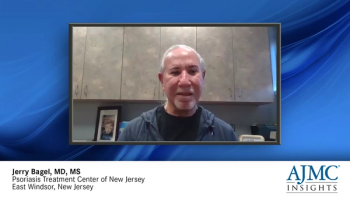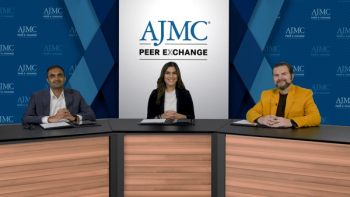
Clinical
Latest News
Latest Videos

CME Content
More News

Panelists discuss how patients with recurrent urinary tract infections (UTIs) describe significant burdens including constant anxiety about symptom onset, disruption to work and social life, financial strain from frequent office visits and medications, frustration with treatment-resistant infections, embarrassment discussing symptoms, sexual dysfunction, relationship difficulties, and substantial mental health impacts such as depression and diminished quality of life.

A panelist discusses how clinicians should systematically adopt evidence-based hidradenitis suppurativa (HS) guidelines while maintaining flexibility to tailor treatments to individual patient needs, severity levels, and comorbidities. This involves regular monitoring of updated recommendations, implementing standardized assessment tools, and considering patient-specific factors such as lifestyle, preferences, and treatment response history to optimize therapeutic outcomes through a personalized medicine approach.

Experts discuss what partnerships between academic and community settings look like with regard to bispecifics, highlighting the role academic centers play in supporting community practices with bispecific therapy protocols.

COVID-19 served as a major catalyst for the widespread adoption of remote patient monitoring, which helps to prevent hospitalizations, improve medication adherence, and enable early interventions by helping providers prioritize high-risk patients.

Joshua Kaufman, MD, of CDPHP, discusses the significance of long-acting injectables (LAIs) in improving adherence, reducing the risk of relapse, and preventing hospitalizations.

Documentation efficiency was higher among younger and male clinicians.

Both refractive and corneal astigmatism saw an increase in prevalence in children after the COVID-19 pandemic, with corneal changes potentially playing a part.

With strong progression-free survival benefits demonstrated in the CABINET trial and updates to National Comprehensive Cancer Network guidelines, this approval reinforces cabozantinib’s role in improving outcomes for patients facing these challenging cancers.

Pulmonary hypertension is a common consequence of interstitial lung disease (PH-ILD), with the highest rate seen among individuals who have idiopathic pulmonary fibrosis. Overall, most cases of PH in the setting of ILD are mild.

The approval of gepotidacin (Blujepa; GSK) introduces the first new class of oral antibiotics for uncomplicated urinary tract infections (UTIs) in nearly 30 years.

New phase 3 data provide reassurance on safety, tolerability, and overall benefit-risk of mirvetuximab soravtansine (Elahere) for patients with folate receptor alpha-positive (FRα+), platinum-resistant ovarian cancer.

Resmetirom offers a targeted approach to metabolic dysfunction–associated steatohepatitis (MASH) for use alongside lifestyle modifications.

These results suggest that the rise in avoidable mortality is driven by widespread factors across the entire US.

The researchers emphasized the need for ongoing research and advocacy to further address drug affordability.

The systemic immune response index outperformed other inflammatory markers in predicting chronic obstructive pulmonary disease (COPD).

Non-Hispanic Black populations face the highest risk of death from chronic kidney disease (CKD)–associated cardiac arrest, a study found.

Investigators used 4D flow cardiovascular magnetic resonance imaging to search for differences between pulmonary artery (PA) remodeling in pulmonary arterial hypertension and other types of pulmonary hypertension.

Panelists discuss how selecting an optimal combination of screening assessments for Alzheimer disease requires careful consideration of test sensitivity, specificity, accessibility, cost-effectiveness, implementation feasibility, and alignment with patient populations and health care resource constraints.

Panelists discuss how comprehensive patient education about proper hygiene practices, adequate hydration, voiding habits, and early symptom recognition significantly reduces urinary tract infection (UTI) incidence and recurrence rates, suggesting enhancement through personalized multimedia resources, telehealth follow-ups, community health programs, and improved provider-patient communication regarding preventive strategies.

Experts discuss the most common logistical challenges encountered when implementing bispecific therapies as well as the primary barriers smaller community practices face in operationalizing bispecific antibody treatments.

Panelists discuss how significant knowledge gaps among nonspecialist providers—particularly regarding differential diagnosis, interpretation of cognitive assessments, and awareness of treatment options—are being addressed through targeted educational initiatives, embedded clinical decision support tools, and collaborative care models to enhance understanding of early Alzheimer diagnosis and treatment importance.

Experts discuss the benefits of implementing and operationalizing bispecifics in the community oncology setting.

A panelist discusses how health system leaders should focus resources on implementing multidisciplinary care teams, standardizing staging/severity assessments, and ensuring access to recommended treatments outlined in current hidradenitis suppurativa (HS) guidelines. Priority areas include early diagnosis through provider education, establishing clear referral pathways to specialists, comprehensive symptom management including pain control, and tracking patient outcomes against quality metrics to improve care delivery and reduce disease burden.

Panelists discuss how uncomplicated urinary tract infection (UTI) recurrence affects 20% to 30% of female patients within 6 months of initial infection, with contributing factors including anatomical variances, hormonal changes, genetic predisposition, insufficient treatment duration, resistant pathogens, and biofilm formation that persists despite proper adherence to standard antibiotic protocols.

The PROMPT trials evaluate the influence of electronic health alerts for informing appropriate, evidence-based therapies to patients with cardiovascular conditions.



















































